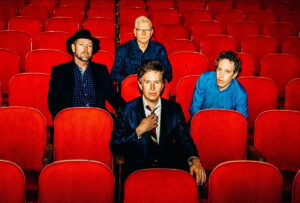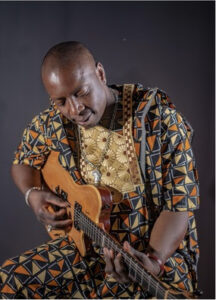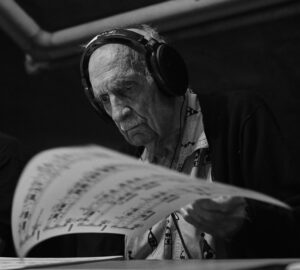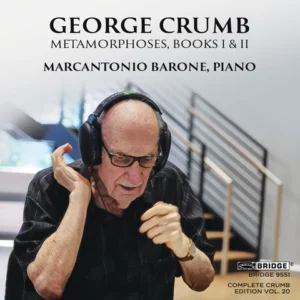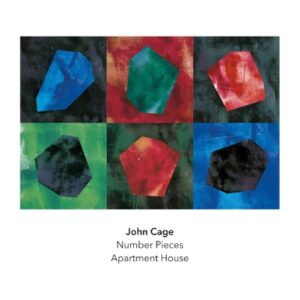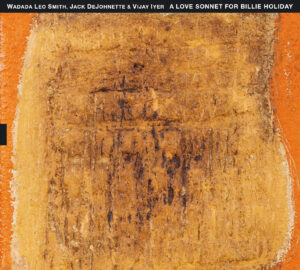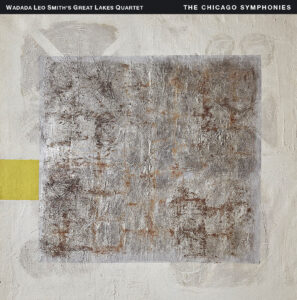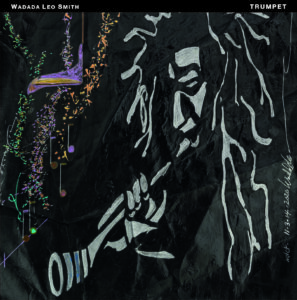On June 10, World Circuit will release Les Racines, an album by Malian guitarist Vieux Farka Touré.
The third single on the album, “Oglala Kaurene,” has been given video treatment. Check out Touré’s guitar stylings, which draw upon the work of previous Malian musicians while remaining distinctive in its deployment of punchy lines and looping polyrhythms. He isn’t known as “Hendrix of the Sahara” for nothing.
Touring
May 13—Freight & Salvage—Berkeley, CA
May 14—Center for the Arts—Grass Valley, CA
May 15—Felton Music Hall—Felton, CA
May 17—Musical Instrument Museum Theater—Phoenix, AZ
May 18—Dakota—Minneapolis, MN
May 19—SPACE—Evanston, IL
May 20—Le Poisson Rouge—New York, NY
May 21—World Café Live—Philadelphia, PA
May 22—Race Street Live—Holyoke, MA
June 8—Crystal Ballroom—Somerville, MA
June 10—Infinity Hall—Norfolk, CT
June 11—StageOne—Fairfield, CT
June 12—Afrika Nyaga Fest—Providence, RI
August 4—Celebrate Brooklyn—Brooklyn, NY
We are saddened to learn of the loss of George Crumb, who passed away on February 6, 2022 at the age of 92. A winner of the Pulitzer Prize, the composer was one of the most important musical figures of his generation, both as a creator and, for many years, as a professor at University of Pennsylvania. Considered by his students to be a supportive and gifted teacher, he mentored a number of composers who went on to major careers.
Crumb composed a large catalog of works, and many of them have become touchstones of the contemporary repertoire. The bracing amplified string quartet Black Angels (1970) decried the atrocities of the Vietnam War; from that same year, the poignant and colorful Ancient Voices of Children is a standout among a host of eloquent settings of Federico Garcia Lorca’s poetry. He often wrote series of pieces; Madrigals from the 1960s for soprano and mixed ensemble, Makrokosmos from the 1970s for amplified piano, and American Songbooks from the 2000s for male and female voices and mixed ensemble are among them. Occasional pieces, including a few depicting his beloved mischievous dogs and a gloss on Thelonious Monk’s “‘Round Midnight,” were witty and equally memorable.

From the outset of his career, Crumb referenced a different set of influences than many of his relative peers, with Bartôk, Debussy, Cowell, Cage, and the burgeoning movement of postmodern Europeans informing him as he struck out on his own path. Crumb was a tremendously imaginative orchestrator, in particular expanding the role and number of percussion instruments in chamber music. The look of his scores, which were frequently graphic in design, was also distinctive. Crumb’s music provided chamber groups, especially new music ensembles, with repertoire that stretched them technically and encouraged them to listen carefully to find the character and balance of the distinctive sound combinations he supplied. His work gave generations of other emerging composers permission to use an expansive set of resources and think outside the box.
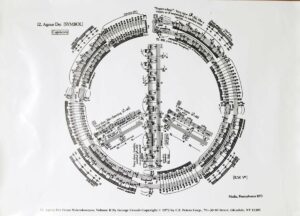
In 2021, a recent piano cycle (2015-2020) in two books, Metamorphoses, in which each piece evoked a work of visual art from a disparate collection of painters, was released on CD by Bridge Records as the twentieth volume of their George Crumb Edition. The composer was involved in the recordings, active until near the end of his extraordinary life.
Number Pieces
John Cage
Apartment House
Another Timbre 4XCD boxed set
John Cage’s Number Pieces, late compositions (from 1987-1992) are given two designations, a number indicating the size of the ensemble and a superscript indicating its order in multiple pieces for the same-sized grouping (Quintet #2 = 52). Fragments of pitches, sometimes single notes, are indicated; dynamics appear sporadically. Rhythm is codified through the use of “time brackets,” indicating how long before a performer can move to another fragment. Most of the pieces are for a particular instrumentation, although a few are unspecified. Thus, while a considerable amount of interpretation remains in the performers’ hands, Number Pieces are less aleatoric than many of Cage’s works from the 1950s to the early 1980s. Commentators have likened some of them to Morton Feldman’s compositions, as both regularly employ soft dynamics and slow tempi, with gradually evolving pitch collections accumulating into pointillist harmonies. While none of these pieces approach a pitch center, in addition to the numerous dissonances one might expect in a Cage piece, it is notable how many minor and major thirds appear in the texture.
Apartment House has recorded a quadruple CD set, released on Another Timbre, of all the number pieces for medium ensembles (from 5 up to 14). It includes some alternative versions and one of the “4” pieces. The group has previously released benchmark recordings on Another Timbre of other New York School repertoire and that of the Wandelweiser Collective, and are thus well-seasoned for this project. If anything, Apartment House surpasses expectations, making much of the subtle distinctions between pieces while presenting a comprehensive collection imbued with Cage’s late musical sensibilities. Excellent liner notes by label owner Simon Reynell help to put Number Pieces into perspective. Quotes from Cage’s late interviews, talks, and writings are edifying in and of themselves, and support the manner that Apartment House has inhabited the Number Pieces they interpret. John Cage: Number Pieces is Sequenza 21’s Recording of the Year.
-Christian Carey
Best of 2021 – Happy 80th Birthday Wadada Leo Smith!
Wadada Leo Smith turns eighty today, and Sequenza 21 wishes him many more years of health, creative improvisation, and composing. Smith has been a driving force as a member of AACM for over five decades, a keen collaborator with jazz and concert musicians, a Pulitzer Prize finalist, and a faculty member at CalArts and elsewhere.
2021 has been a prolific one in terms of record releases by the trumpeter and composer. He is joined by wind player Douglas Ewart and drummer Mike Reed on the Astral Spirits CD Sun Beams of Shimmering Light. The standout opening movement is a sixteen-minute long suite “Constellations and Conjunctional Spaces” which begins with fragmentary utterances that build into long, florid lines that are succeeded by riotous free play. A short coda sees motives from the top of the piece reexamined in light of what has transpired in between.
TUM has released four recordings by Smith this calendar year, with a seven-CD collection of string quartets on deck for early 2022. The only single CD among these is A Love Sonnet for Billie Holiday, which features a trio with his frequent collaborators pianist Vijay Iyer and drummer Jack DeJohnette, marking the first time all three have worked together. It is a winning grouping, as are the two included duos with DeJohnette. As Smith points out in the liner notes, the approach here alludes to his work with Anthony Braxton and Leroy Jenkins on “The Bell,” a piece from his debut album in 1969. This affinity is both in terms of interaction and collaboration, but also in a harmonic language more recognizable in Smith’s earlier music.
The Great Lakes Quartet, which includes saxophonist Leroy Jenkins (on some tracks Jonathon Haffner), DeJohnette, and bassist Henry Lindberg, is the personnel on the TUM double CD The Chicago Symphonies. There are four pieces here, Gold, Diamond, Pearl, and Sapphire, subtitled “The Presidents Symphony: Their Visions for America; Abraham Lincoln at Gettysburg and Barack Obama at Selma!” How can a quartet play “symphonies,” one might wonder before listening. But upon engaging with these recordings, it is clear that the formal designs, development of thematic material, and use of all of the instruments’ capabilities to the utmost engage with music writ large.
A triple CD of solo trumpet music might seem like a long sit, but Smith’s individual performances on Trumpet are riveting. He recorded these fourteen new pieces, many of them extended, sculpted works, in a single weekend at St. Mary’s Church in the town of Pohja, on the Southern Coast of Finland, which provides a great acoustic for Smith’s luminous sound. Finally (for now), Sacred Ceremonies, a three disc recording with bassist Bill Laswell and Milford Graves, visionary drummer of the New York “new wave” free jazz scene, who passed away in February, 2021 and to whom the recording is dedicated. The first CD features a duet between Smith and Graves, the second, Smith with Laswell, and the third is a trio. The level of rhythmic layering in the trumpet and drums duos is truly astonishing. Quotation plays a large role, with Smith imitating Graves’ gestures but choosing melodic lines from blues, standards, and even nursery rhymes to cross-pollinate the music. Laswell adds elements of funk and avant-pop to the mix; Smith responds in places by playing through a wah-wah pedal and employing minimal patterning. The trio is a summit of experimental practices, and the polyglot musical language they form together is inimitable and now, sadly, with the passing of Graves, irreplaceable.
- Christian Carey
This podcast examines Voices of the Pearl, a particularly interesting project that combines the rediscovery of ancient religious texts, the setting of these texts by women into chamber music by contemporary composers and the historical role of women in sacred music. Our guests are Dr. Anne Harley, Artistic Director of the Voices of the Pearl project and Dr. Stacey Fraser, soprano. The podcast will explore the music of their third and latest CD album. With Jim Goodin.

Roland de Lassus
Inferno – Motets for Six and Eight Voices
Cappella Amsterdam, Daniel Reuss, director
Harmonia Mundi CD
Roland de Lassus (1530-1594) – also known as Orlando di Lasso – was one of the most important vocal composers of the sixteenth century. His extant catalog contains more than 2,000 pieces in nearly every sacred genre as well as madrigals, chansons, and lieder. Much of his career was spent in Munich in the service of Duke Albrecht V of Prussia. The motets that appear on Inferno, a Harmonia Mundi CD of six and eight voice pieces, come from this stage of his career. They are penitential in character, the last published motets taking on a particularly melancholy demeanor that seems to impart the composer’s reflections on mortality in old age.
Cappella Amsterdam, directed by Daniel Reuss, has a beautiful sound, superbly balanced with warmth in every register. Reuss shapes the programmed pieces to demonstrate clarity of counterpoint, expressivity of utterance, and, importantly, the resonance that these frequently mournful works require.
Among several standout performances, particularly affecting is Media vita in morte sumus, which is preceded by a limpidly executed rendition of its plainchant. The motet contains considerable antiphony, a technique that Lassus uses in a fashion reminiscent to Adrian Willaert’s choral music for St. Mark’s in Venice. In Omnia tempus habent, Lassus similarly splits up the voices, with ricocheting entrances offset by rich, tutti eight-part textures.
Lassus was also a master of word-painting. Published the year of Lassus’s death, Deficiat in dolore vita mea, has a particularly plaintive cast, its text a paraphrase of Psalm 30, verse 11: “Let my life end in grief, and my years in groans, that I may find rest in the day of tribulation” – set as a moving bewailment. From the same 1594 collection of six-voice motets, Vidi Calumnias begins with staggered entrances that gradually give way to scintillating chords.
Not all of the texts are ones of mourning. Published somewhat earlier, in 1582, Cum essem parvulus sets one of the most beloved passages of Paul’s First Letter to the Corinthians, “When I was a child, I spoke as a child …” with florid canonic passages offset by richly voiced harmonies. Thus, while Inferno is a solemn document, it is still one that contains glimmers of hope around its edges. Best choral release 2020.
-Christian Carey

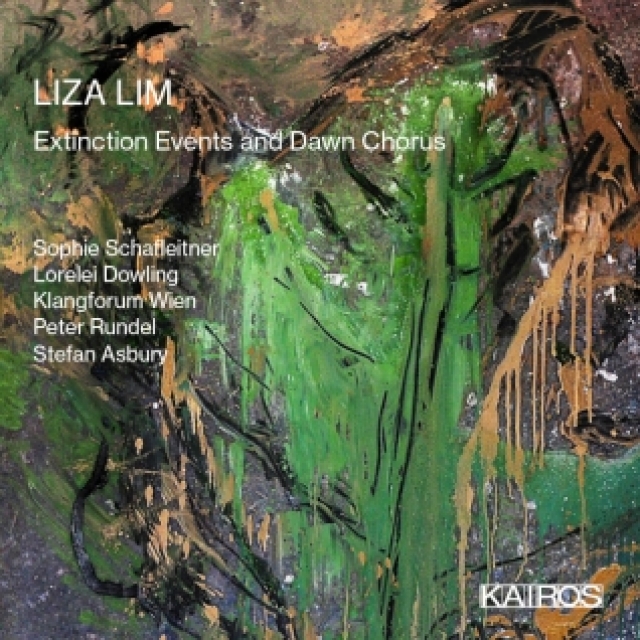
Liza Lim
Extinction Events and Dawn Chorus
Sophie Schatleitner, violin; Lorelei Dowling, bassoon;
Klangform Wien, Stefan Asbury and Peter Rundel, conductors
Kairos CD 00140220KAI
Composer Liza Lim’s creative projects have long embraced a variety of ecomusicology. The environment in her home country Australia and the treatment of indigenous peoples there have featured in several works. 2018’s Extinction Events and Dawn Chorus casts an even broader net, addressing concerns of climate change worldwide. Scientific studies assessing projected extinction of flora and fauna due to the impact of the climate change disaster suggest that, unless humanity changes its ways quickly, a vast number of creatures vital to the ecosystem will no longer remain.
Narrative in instrumental music is an elusive business. However, like John Luther Adams and R. Murray Schafer, Lim is adroit at creating aural imagery that is evocative of environmental subject matter. Rain sticks, air-filled noises, and terse, insectile solos provide a sense of place and population to the piece. Baying brass announce movement breaks with poignant glissandos. The third movement, Autocorrect, features fluid solos by violinist Sophie Schatleitner offset by microtonal bends in the brass and flourishes from winds and percussion. During Dawn Chorus, the last movement, extended woodwind drones and terse sepulchral lines provide a slow-moving, harmonics filled background.
Especially impressive is the 2013 solo bassoon piece Axis Mundi, which is performed by Lorelei Dowling. Angular lines and glissandos that frequently fade are set against boisterous trills and blatting bass notes. It parses the piece into clear registral areas to create post-tonal and timbrally enhanced counterpoint that allows the disparate parts of the piece to cohere.
Songs Found in a Dream uses a similar palette as Extinction Events, feeling something like a more boisterous sketch for the larger work. However, Songs’ quicker pacing and frequently saturated textures distinguish it from the latter piece. On both works, Klangforum Wien creates supple, nuanced, and, where necessary, powerful performances. The Kairos CD sounds excellent, with a strong feeling of dimensionality among the various parts of the ensemble. Highly recommended.
-Christian Carey

Páll Ragnar Pálsson
Atonement
CAPUT Ensemble, conducted by Guðni Franzson, Tui Hirv, Ásdís Sif Gunnarsdóttir
Sono Luminus CD/Blu-ray (2020)
Halldór Smárason
Stara
Siggi String Quartet, Emilía Rós Sigfúsdóttir, Geirþrúður Ása Guðjónsdóttir, Helga Björg Arnardóttir, Tinna Thorsteinsdóttir, Gulli Björnsson
Sono Luminus CD/Blu-ray (2020)
In recent years, the prominence of Icelandic composers on the international stage has grown considerably, many of them championed by the Sono Luminus label. New discs on the imprint are portraits of two more composers whose careers are in ascent: Páll Ragnar Pálsson (b. 1977) and Halldór Smárason (b. 1989). They are abetted by some of Iceland’s finest chamber musicians, the Siggi String Quartet and CAPUT Ensemble.
This is Pálsson’s second solo CD, consisting of works written from 2011 to 2018. He has a varied background. In his twenties he was a rock musician and then took an extended sojourn for studies in Estonia. Atonement encompasses those experiences and is also about the composer’s return to Iceland after his time abroad. Pálsson says that the importance of place is a significant touchstone for his approach to composing.
Relationships also play a pivotal role in his work. The abundantly talented soprano Tui Hirv is Pálsson’s spouse. She features prominently in several pieces, singing minute shadings and sustained high passages with tremendous dynamic control and expressivity in the title work. On Stalker’s Monologue, singing a text adapted from the Tarkovsky film, Hirv demonstrates more vocal steel and the accompaniment takes on a bleary-eyed cast. Midsummer’s Night features recited text instead of singing, with a poem by Ásdís Sif Gunnarsdóttir.
The CAPUT Ensemble acquits themselves admirably as well. Lucidity features the ensemble crafting microtonal shadings and exaggerated trills, the latter sometimes doubled in strings and winds to kaleidoscopic effect and punctuated by swells of percussion. The extended ensemble passages on Wheel Crosses Under Moss are an excellent response to the keening part sung by Hirv.

Smárason’s debut solo CD features the Siggi String Quartet. The title work is a good example of the composer’s aesthetic. Spacious use of silence is complemented by long sustained notes that generally have an “edge to them,” in terms of dissonance or playing technique. The quartet are dispatched on a similar errand on the piece Draw and Play, but the gestures between the rests are more animated. Blakta, also for strings, features gentle pizzicato against harmonics and upper register pileups of verticals.
A guitar and electronics piece, Skúlptúr 1, requires the performer, Gulli Björnsson, to make his way through a challenging hop scotch of techniques in a specified time frame in order to avoid an alarm from the electronics part. Happily he makes it on the recording.
The best piece on Stara is also the one for the largest ensemble, Stop Breathing. The Siggi Quartet is augmented with bass flute, clarinet, and piano. Breathy whorls and wind glissandos are set against harmonic ostinato passages as well as aggressive squalls of sound.
A number of current composers are concerned with silence and pianissimo stretches. On Stara, Smárason distinguishes himself by filling in the silence with music of an uneasy demeanor from which one receives little respite or release. His work is unerringly paced and delicately unnerving. Both Atonement and Stara contain excellent performances of provoking works: recommended.
-Christian Carey

Celebrating a new partnership between Nonesuch and International Anthem, two of the gold standard labels for adventurous music, January 24 will see the release of Jeff Parker and the New Breed’s Suite for Max Brown. Combining samples, some decidedly old school in origin, and exploratory improvisation, the music makes connections to Parker’s long tenure in Tortoise while adding still more depth to his musical profile.
Listeners will doubtless wonder: who is Max Brown? Parker’s mother’s maiden name was Maxine Brown, but her nickname is Max. The New Breed band name comes from the name of a store owned by Parker’s late father. Thus, the entire project is enacted as a tribute to family. The suite is Parker’s most personal, musically potent, statement to date.
